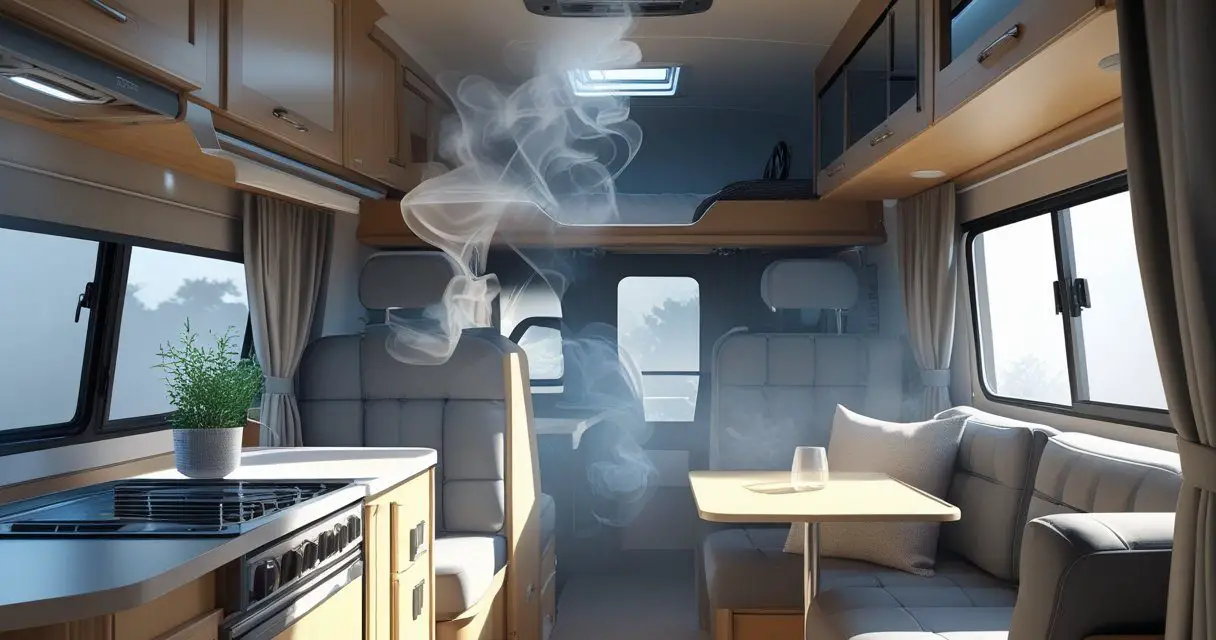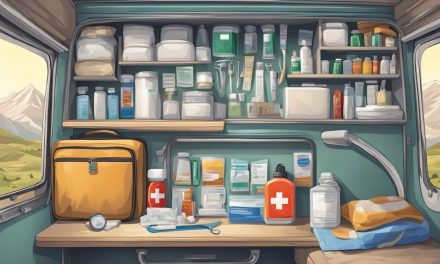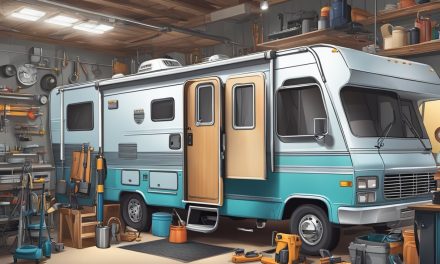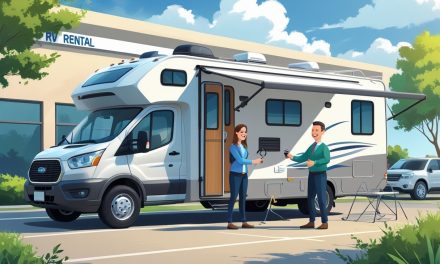Would you like to save this article?
The shocking truth about RV health risks that could save your life on the road
Are you living your dream RV life? Or could your home on wheels be quietly making you sick?
With over 11 million American households now owning RVs, more families than ever are hitting the road. But here’s what the glossy RV magazines won’t tell you: your RV could be harboring serious health dangers that range from annoying to deadly.
After analyzing thousands of RV health reports and speaking with medical experts, we’ve uncovered 20 major health problems that can develop when you live in an RV. The good news? Most are completely preventable when you know what to look for.
Why RVs Can Be Health Hazards (The Science Explained)
Here’s the simple truth: RVs are small, enclosed spaces with limited ventilation and concentrated living. When you add in constant movement, extreme temperatures, and aging systems, you’ve got a perfect storm for health problems.
But don’t panic! Understanding these risks is the first step to preventing them. Most RV health issues develop slowly over time, which means you can stop them before they start.
🚨 The Top 20 Health Dangers of RV Living
1. Carbon Monoxide Poisoning (The Silent Killer)
The Deadly Truth: Carbon monoxide kills more RVers than any other single cause. This invisible, odorless gas is responsible for hundreds of deaths each year in recreational vehicles.
The danger comes from multiple sources in your RV. Your generator, propane appliances, and even nearby RVs can create deadly concentrations of this gas.
Carbon monoxide can come from:
- Your RV’s generator
- Nearby RVs running generators
- Faulty propane appliances
- Blocked exhaust systems
- Running your engine in enclosed spaces
Warning Signs You Need to Know:
- Sudden headaches
- Dizziness or confusion
- Nausea and vomiting
- Feeling tired for no reason
- Cherry-red lips or fingernails
Life-Saving Prevention Steps:
Install multiple CO detectors throughout your RV – one near sleeping areas and one in the main living space. Replace detectors every 5-7 years because most people forget this critical maintenance step.
Never run generators near open windows or doors. Have your propane system inspected annually by a certified technician. Never idle your engine in enclosed areas or when parked close to other RVs.
2. Toxic Mold Growth (The Hidden Invader)
The Problem: RVs create perfect conditions for mold growth. Poor ventilation systems, temperature changes that create condensation, and water leaks from aging seals all contribute to this dangerous problem.
High humidity from cooking and showering makes the situation even worse. Once mold takes hold, it can spread rapidly throughout your small living space.
Where Mold Hides in Your RV:
- Under mattresses and cushions
- Behind wall panels
- In air conditioning vents
- Around windows and doors
- Inside storage compartments
Health Impact of Mold Exposure:
Mold doesn’t just smell bad – it can seriously damage your health. Respiratory infections are common, along with chronic fatigue that won’t go away with rest.
Many RVers develop allergic reactions they never had before. Neurological problems and weakened immune systems are also serious concerns from long-term mold exposure.
Proven Mold Prevention Strategy:
Run a powerful dehumidifier because small, cheap units don’t work in RV environments. Always use exhaust fans when cooking or showering, even if it seems like overkill.
Check for roof leaks monthly, especially around vents and air conditioning units. Install moisture-absorbing products in closets and storage areas. Replace old caulk around windows annually to prevent water intrusion.
3. Dangerous Air Quality Problems
The Hidden Threat: Your RV’s air quality might be worse than city smog. RVs trap dangerous chemicals called VOCs (Volatile Organic Compounds) that come from everyday items.
These chemicals build up in your small space and can cause both immediate and long-term health problems. The concentration is often much higher than what you’d find in a traditional home.
VOC Sources in Your RV:
- Furniture glue and fabrics
- Cleaning products
- Building materials
- Carpet and flooring
- Air fresheners and scented products
Health Symptoms from Poor Air Quality:
Headaches and dizziness are often the first signs of air quality problems. Breathing problems can develop gradually and worsen over time.
Eye and throat irritation might seem minor but shouldn’t be ignored. Long-term organ damage is a serious risk from continuous exposure to these chemicals.
Air Quality Solutions That Work:
Open windows daily for fresh air circulation, even in cold weather for short periods. Install high-quality HEPA air purifiers designed for small spaces – cheap units won’t filter effectively.
Use only natural cleaning products without harsh chemicals. Add houseplants that clean air naturally, like spider plants and peace lilies. Test your RV’s air quality regularly with home testing kits.
4. Formaldehyde Off-Gassing (New RV Danger)
The Problem: Newer RVs often contain formaldehyde in walls, floors, and cabinets. This chemical “off-gases” into your living space, especially during the first year after manufacturing.
The smell is often described as “new RV smell,” but it’s actually toxic fumes. The concentration can be particularly dangerous in small, enclosed RV spaces.
Symptoms to Watch For:
- Itchy, watery eyes
- Sore throat that doesn’t go away
- Nasal irritation and runny nose
- Coughing and wheezing
- Nausea without other cause
- Skin rashes and irritation
Quick Formaldehyde Removal Method:
Remove all food, plants, and clothing from your RV first. Open all cabinet doors and drawers to maximize air exposure.
Close all windows and vents completely. Turn your thermostat to the highest setting and leave the RV heated for 12 hours.
After heating, turn off the thermostat and open everything. Run fans for 6 hours to pull the gases out of your RV.
5. Propane System Hazards
Life-Threatening Risks: Propane systems in RVs create multiple dangers that many owners underestimate. Gas leaks can lead to explosive situations with little warning.
Carbon monoxide from incomplete combustion is a silent killer. Burns from improper handling can cause permanent injuries.
Critical Propane Safety Protocol:
Inspect your propane system monthly for leaks using soapy water on all connections. Install gas detectors near floor level since propane is heavier than air.
Turn off propane when not actively using appliances. Never use propane appliances for heating sleeping areas. Get professional service immediately for any suspected problems.
6. Fire Hazards (8x Faster Spread)
Shocking Fact: RV fires spread 8 times faster than house fires. The lightweight, flammable materials used in RV construction create extremely dangerous fire conditions.
You have much less time to escape than you would in a traditional home fire. Many RV fires become fully engulfed within minutes of starting.
Common Fire Causes in RVs:
- Electrical system overloads from too many devices
- Faulty RV refrigerators (check manufacturer recall notices!)
- Unattended space heaters
- Cooking accidents from cramped kitchen spaces
- Propane leaks that ignite
Essential Fire Prevention Checklist:
Keep multiple fire extinguishers in easy-reach locations throughout your RV. Never leave cooking unattended, even for a minute.
Avoid using extension cords with space heaters, which can overload circuits. Check recall notices regularly for your specific RV model and appliances.
Practice your escape plan monthly with all family members. Know where every exit is and how to open them quickly in darkness.
7. Water Quality Issues (42% Contamination Rate)
Scary Truth: Studies show that 42% of RV water systems contain harmful bacteria, chemicals, or heavy metals. Your water source changes constantly, and your RV’s plumbing can harbor dangerous contaminants.
Many RVers don’t realize their water system needs regular maintenance and testing. Contaminated water can cause both immediate illness and long-term health problems.
Common Water Problems:
- Bacteria growth in holding tanks
- Chemical contamination from non-food-grade hoses
- Heavy metals from old plumbing systems
- Chlorine and treatment chemicals in high concentrations
Clean Water Solutions:
Install a whole-RV water filtration system, not just a simple inline filter. Sanitize your fresh water tank monthly with approved sanitizing solutions.
Use only food-grade water hoses and replace them regularly. Test your water regularly with home test kits for bacteria and chemicals.
Always carry backup drinking water for emergencies. Never assume campground water is safe without testing.
8. Mental Health Challenges
The Hidden Crisis: 37% of full-time RVers report significant mental health struggles that they didn’t anticipate. The constant close quarters and uncertainty can take a serious toll.
Claustrophobia from small spaces affects even people who never experienced it before. Anxiety from constant uncertainty about weather, breakdowns, and money becomes overwhelming for many.
Depression from social isolation is common when you’re constantly moving. Relationship stress from lack of privacy can strain even strong partnerships.
Mental Health Protection Strategies:
Create separate personal spaces within your RV, even if they’re tiny. Schedule regular alone time outdoors away from your partner or family.
Join RV communities both online and in-person for social connection. Maintain routines even while traveling to provide stability and normalcy.
Consider teletherapy if you’re struggling – many therapists now offer remote sessions perfect for RV life.
9. Serious Ergonomic Problems
The Problem: RV furniture prioritizes space-saving over body health. Poor seating leads to chronic back pain that gets worse over time.
Low ceilings cause neck problems from constantly ducking. Cramped quarters create joint stiffness and repetitive strain injuries.
Body-Saving Solutions:
Invest in a high-quality RV mattress designed for your specific space. Use ergonomic seat cushions and lumbar support for driving and relaxing.
Take hourly stretch breaks during long drives, even if you’re eager to reach your destination. Set up an outdoor workspace when possible to escape cramped indoor conditions.
Do daily exercises specifically designed to counteract cramped living conditions. Yoga and stretching routines work well in small RV spaces.
10. Poor Nutrition and Food Safety
The Challenge: Limited storage forces many RVers to rely on processed foods high in sodium and chemicals. Inadequate refrigeration can cause food spoilage and foodborne illness.
Limited fresh produce intake leads to vitamin deficiencies over time. Eating out too frequently becomes expensive and unhealthy.
Healthy Eating Strategies:
Shop frequently for fresh foods instead of trying to stock up for weeks. Invest in high-quality mini appliances that work efficiently in small spaces.
Learn meal prep techniques specifically designed for RV kitchens. Grow your own herbs in containers for fresh flavors and nutrients.
Plan nutritious meals in advance to avoid impulsive food choices. Focus on nutrient-dense foods that don’t require much storage space.
11. Extreme Temperature Exposure
The Danger: RVs have notoriously poor insulation compared to traditional homes. Summer heat can cause heat exhaustion and dehydration rapidly.
Winter cold can lead to hypothermia if heating systems fail. Poor climate control disrupts sleep and weakens your immune system.
Temperature Control Tips:
Upgrade insulation in problem areas like windows and doors. Use reflective window covers to block heat in summer.
Install efficient heating and cooling systems appropriate for your RV size. Monitor humidity levels constantly as they affect comfort and health.
Dress in layers and keep emergency supplies for temperature extremes. Have backup heating and cooling plans for system failures.
12. Limited Healthcare Access
Real Consequences: Remote RV locations often mean delayed treatment for serious conditions. Skipped preventive care and checkups can allow problems to worsen.
Medication access becomes difficult in rural areas. Emergency response times can be dangerously long in remote camping areas.
Smart Healthcare Planning:
Research medical facilities before traveling to any area. Maintain telehealth relationships with your regular doctors for continuity of care.
Keep comprehensive medical records with you, including medication lists and allergies. Stock up on prescriptions before heading to remote areas.
Consider medical travel insurance that covers emergency transportation. Know the location of nearest hospitals wherever you camp.
13. Wildlife and Pest Exposure
Hidden Health Threats: Disease-carrying ticks spread Lyme disease and Rocky Mountain spotted fever in many camping areas. Mosquito-borne illnesses like West Nile and Zika are increasing risks.
Rodent droppings can carry Hantavirus, which can be fatal. Venomous snake encounters are more likely when you’re camping in their natural habitat.
Protection Strategies:
Seal all entry points to prevent rodents from getting inside your RV. Use EPA-approved insect repellents containing DEET or picaridin.
Check for ticks daily after any outdoor activities, paying special attention to hidden areas. Store food properly in sealed containers to avoid attracting dangerous wildlife.
Learn local wildlife safety rules for each area you visit. Carry appropriate first aid supplies for bites and stings.
14. Electrical System Dangers
The Risk: Faulty RV electrical systems cause electric shock injuries and fires from overloaded circuits. Damaged systems can produce carbon monoxide in unexpected ways.
Improper grounding can lead to electrocution, especially around water sources. Many RV electrical problems develop gradually and go unnoticed.
Electrical Safety Rules:
Have your electrical system inspected annually by a certified RV technician. Never overload circuits with too many high-power devices.
Use proper surge protection designed for RV electrical systems. Check GFI outlets monthly to ensure they’re working properly.
Hire professionals for any electrical work – RV electrical systems have unique requirements. Never attempt DIY electrical repairs unless you’re trained.
15. Road Safety and Accident Injuries
Sobering Statistics: RV accidents are 3 times more likely to result in serious injury due to physics and design factors. Higher center of gravity makes rollovers more common.
Longer stopping distances catch many drivers off guard. Poor visibility creates blind spots that cause accidents.
Driver inexperience with large vehicles leads to preventable crashes.
Accident Prevention:
Take a professional RV driving course before your first major trip. Drive slower than you think you need to, especially in unfamiliar areas.
Avoid driving in high winds or severe weather conditions. Secure all items inside your RV before moving – loose objects become projectiles in accidents.
Use proper safety restraints for all passengers. Never allow passengers to move around while driving.
16. Sleep Disruption and Fatigue
The Problem: Poor sleep quality in RVs leads to chronic fatigue that affects every aspect of your health. Weakened immune systems make you more susceptible to illness.
Poor decision-making from fatigue increases accident risk. Temperature fluctuations and noise disrupt natural sleep cycles.
Sleep Improvement Tips:
Invest in blackout curtains specifically designed for RV windows. Use white noise machines to mask outside sounds.
Maintain consistent sleep schedules even while traveling across time zones. Create a comfortable sleeping environment with proper bedding and temperature control.
Limit screen time before bed to improve sleep quality. Consider natural sleep aids if you’re having ongoing problems.
17. Sitting Disease (Yes, It’s Real!)
The Health Risk: Excessive sitting while driving and relaxing causes serious health problems. Slowed metabolism increases diabetes and heart disease risk.
Blood circulation problems can lead to dangerous blood clots. Depression and anxiety are linked to sedentary lifestyles.
Movement Solutions:
Take hourly walking breaks during long driving days. Stand while talking on the phone instead of sitting.
Exercise outside daily, even if it’s just a short walk around the campground. Use a standing desk setup for computer work.
Park farther from destinations to force more walking. Choose active campground activities over passive entertainment.
18. Hygiene and Sanitation Issues
The Problem: Limited water supply and small spaces can compromise personal hygiene. Poor hygiene leads to bacterial infections and skin conditions.
Dental health problems develop from inconsistent routines. Waste system problems can create serious sanitation hazards.
Hygiene Solutions:
Install efficient shower systems that conserve water while providing adequate cleaning. Use waterless hygiene products for times when water is limited.
Maintain proper waste system care with appropriate chemicals and pumping schedules. Schedule regular visits to full-facility campgrounds for thorough cleaning.
Keep emergency hygiene supplies for situations when normal facilities aren’t available.
19. UV Radiation Exposure
The Danger: Constant outdoor living dramatically increases UV exposure. Skin cancer risk multiplies with extended sun exposure.
Premature aging accelerates from UV damage. Eye damage can lead to cataracts and other vision problems.
Heat stroke becomes more likely with extended outdoor exposure.
UV Protection:
Use broad-spectrum sunscreen daily, even on cloudy days. Install UV-blocking window film on all RV windows.
Wear protective clothing and wide-brimmed hats when outside. Seek shade during peak UV hours from 10am to 4pm.
Get regular skin cancer screenings from dermatologists. Protect your eyes with quality UV-blocking sunglasses.
20. Chemical Exposure from RV Materials
The Risk: Older RVs may contain dangerous materials that were legal when manufactured. Asbestos in insulation can cause lung cancer and mesothelioma.
Lead in paint and plumbing creates neurological risks. Toxic flame retardants off-gas into your living space.
Harmful plasticizers from vinyl materials can disrupt hormones.
Protection Strategies:
Test older RVs for harmful materials before purchasing or renovating. Improve ventilation systems to reduce chemical concentrations.
Use natural cleaning products instead of harsh chemicals. Replace old materials with safer alternatives when renovating.
Monitor family members for health symptoms that might indicate chemical exposure.
📊 Quick Reference: RV Health Emergency Kit
Every RV should carry essential health monitoring and emergency equipment:
| Category | Must-Have Items |
|---|---|
| Air Quality | HEPA air purifier, CO detector, VOC test strips, mold test kit |
| Fire Safety | 3+ fire extinguishers, smoke detectors, escape ladder, fire blanket |
| First Aid | Comprehensive kit, prescription meds, emergency contacts, thermometer |
| Water Safety | Water test kit, filtration system, sanitizing tablets, backup water |
| Weather Protection | Emergency heating/cooling, insulation materials, temperature monitor |
🚑 When to See a Doctor Immediately
Some symptoms require immediate medical attention and shouldn’t be ignored:
Get emergency help if you experience:
- Sudden, severe headaches that feel different from normal headaches
- Difficulty breathing or chest pain
- Persistent nausea or dizziness that doesn’t improve with rest
- Unexplained skin rashes that spread or worsen
- Extreme fatigue that doesn’t improve with sleep
- Loss of consciousness or confusion
- Cherry-red lips or fingernails (classic sign of CO poisoning)
Don’t hesitate to call 911 if you suspect carbon monoxide poisoning. Get everyone outside to fresh air immediately.
💡 The Bottom Line: Is RV Living Safe?
Absolutely, YES! RV living can be completely safe when you prepare properly and stay vigilant about potential health risks.
The key is education and prevention. Most RV health problems develop slowly over time, which gives you opportunities to prevent them entirely with the right knowledge and tools.
Remember this important truth: Your health is worth more than any Instagram-worthy sunset photo. Take these risks seriously, but don’t let fear prevent you from enjoying the RV lifestyle you love.
Thousands of RVers live safely and healthily on the road by following proper precautions. You can too with the right preparation and ongoing vigilance.
✅ Your RV Health Action Plan
Step 1: Audit your current RV for the health risks mentioned above using this article as a checklist.
Step 2: Create a prioritized action plan to address your biggest concerns first, focusing on life-threatening risks like carbon monoxide.
Step 3: Invest in quality safety equipment – remember that it’s much cheaper than medical bills or insurance claims.
Step 4: Stay educated about RV health topics and safety updates by joining RV forums and following safety organizations.
Step 5: Join RV communities where you can learn from experienced travelers who have faced and solved these challenges.
🔬 The Science Behind RV Health Risks
Research shows that people living in small, enclosed spaces face unique health challenges that don’t affect traditional homeowners:
Air circulation in RVs is typically 60% less effective than traditional homes due to space constraints and design limitations.
Humidity levels can fluctuate by 40% or more daily in RVs due to cooking, showering, and weather changes. Chemical concentrations are 2-5 times higher in small spaces because pollutants can’t disperse effectively.
Carbon monoxide builds up 8 times faster in RVs than houses due to volume and ventilation differences. These aren’t just abstract numbers – they represent real health impacts that smart RVers can prevent with proper preparation.
Meta Description: Discover the 20 hidden health dangers of RV living that could make you sick. Learn proven prevention strategies, safety tips, and emergency protocols every RV owner needs to protect their family’s health on the road. From carbon monoxide to mold, get the complete guide to staying healthy in your RV.
Sources:
- National Fire Protection Association RV Fire Statistics
- Centers for Disease Control and Prevention Carbon Monoxide Safety
- Environmental Protection Agency Indoor Air Quality
- Recreational Vehicle Industry Association Safety Guidelines
- American Red Cross RV Safety Resources
- RV Safety & Education Foundation
- CDC Carbon Monoxide Poisoning Deaths Associated with Camping
- National Institute for Occupational Safety and Health Indoor Air Quality
- American Lung Association Indoor Air Quality
- RV Industry Association Health and Safety Studies





